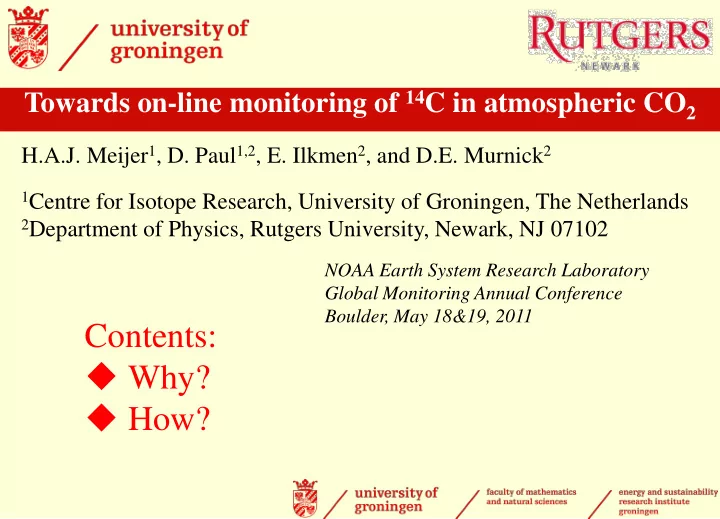

Towards on-line monitoring of 14 C in atmospheric CO 2 H.A.J. Meijer 1 , D. Paul 1,2 , E. Ilkmen 2 , and D.E. Murnick 2 1 Centre for Isotope Research, University of Groningen, The Netherlands 2 Department of Physics, Rutgers University, Newark, NJ 07102 NOAA Earth System Research Laboratory Global Monitoring Annual Conference Boulder, May 18&19, 2011 Contents: Why? How?
Anthropogenic CO 2 production
The increase of atmospheric CO 2 is half of what we expect
The European carbon balance (TgC/yr) (positive numbers: flux into the atmosphere)
Need of methods to distinguish “natural” from fossil CO 2 • Fossil fuel CO 2 is by far the dominant net source • Commercial statistics are not accurate enough: neither in place, nor in time • The Kyoto (and successor!) treaties require reliable and verifiable CO 2 emission data to independently check measures and agreements #1 candidate: 14 C: “Radiocarbon”
14 C or Radiocarbon Radio-active (half life 5730 yrs), so fossil fuel is 14 C-free Extremely rare: abundance of 10 -12 in modern carbon 404 ppm 400 ppm “1” / 0 ‰ “0.99” / -10 ‰ Add 1% CO 2 -ffx 14 C 14 C CO 2 CO 2 1 ‰ precision in 14 C corresponds to 0.4 ppm CO 2 -ffx
14 CO 2 in The Netherlands compared to European background High Alpine station Jungfraujoch (3500 m) Data from the Dutch coastal station Lutjewad Van der Laan et al., Tellus (2010), 62B, 389–402
Measurements of the fossil fuel CO 2 concentration for the Netherlands
14 C measurements are expensive and labor-intensive Samples need to be taken individually (either “grab samples” or integrated ones) Need to be transported to an AMS facility Need extensive pretreatment: Extraction of CO 2 , graphitization, target preparation Require a complicated and expensive facility: AMS installation CIO Groningen University
The alternative: ICOGS Intra Cavity Opto Galvanic Spectroscopy Intracavity 14 CO 2 laser tube P otential for continuous Sample cell in situ 14 CO 2 measurements Daniel E.Murnick et al., Reference Analytical Chemistry 2008, 4820- 12 CO 2 laser cell 4824
Lincoln Laboratory Journal , 3 , 491 (1990) Laser resonances in CO 2 are Isotope Dependent SELECTIVITY 14 CO 2 laser transition At 11.8 µ
SENSITIVITY achieved through THE OPTOGALVANIC EFFECT (OGE) and high (intra-cavity) laser power Laser radiation changes distribution of various species within an electrical discharge which changes the electron energy distribution function. This leads to an easily measurable impedance change of the system .
ICOGS, similar to IRMS and AMS, produces a Double Ratio Signal: 14 C sample / 12 C sample “DR”= 14 C ref / 12 C ref 1.2 1 Normalized OGE Signal (V) 0.8 0.6 0.4 0.2 0 0 0.2 0.4 0.6 0.8 1 1.2 1.4 1.6 1.8 C14 "Modern"
High Potential: signal precision corresponds to <1‰ Items to be (re)solved: non-linearity Drift of reference cell P and T dependence Electrical Noise 13 C dependence
We’ll keep you posted! Harro Meijer Erhan Ilkmen Dipayan Paul Daniel Murnick Support: NSF Grant (Newark), RWE grant (Groningen)
Recommend
More recommend